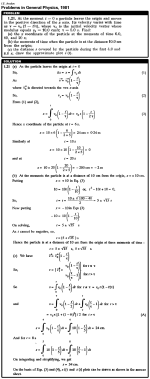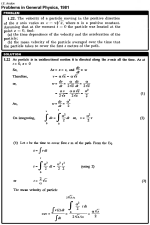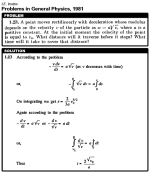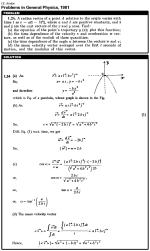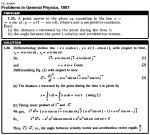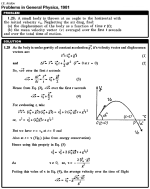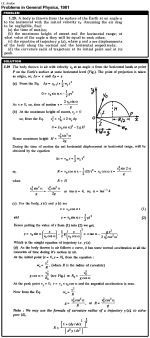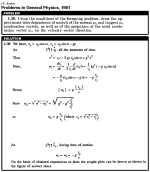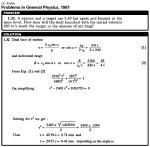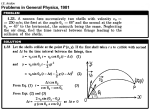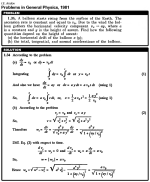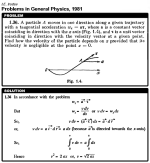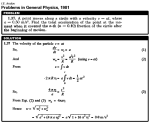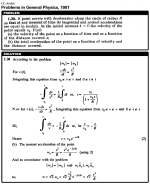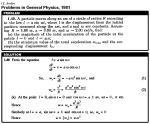| № |
Condition |
free/or 0.5$ |
| 21 | At the moment t = 0 a particle leaves the origin and moves in the positive direction of the x axis. Its velocity varies with time as v = v0 (1 - t/τ), where v0 is the initial velocity vector whose modulus equals v0 = 10.0 cm/s; τ = 5.0 s. Find: (a) the x coordinate of the particle at the moments of time 6.0, 10, and 20 s; (b) the moments of time when the particle is at the distance 10.0 cm from the origin; (c) the distance s covered by the particle during the first 4.0 and 8.0 s; draw the approximate plot s(t). |
|
| 22 | The velocity of a particle moving in the positive direction of the x axis varies as v = α sqrt(x), where α is a positive constant. Assuming that at the moment t = 0 the particle was located at the point x = 0, find: (a) the time dependence of the velocity and the acceleration of the particle; (b) the mean velocity of the particle averaged over the time that the particle takes to cover the first s metres of the path. |
|
| 23 | A point moves rectilinearly with deceleration whose modulus depends on the velocity v of the particle as w = a sqrt(v), where a is a positive constant. At the initial moment the velocity of the point is equal to v0. What distance will it traverse before it stops? What time will it take to cover that distance? |
|
| 24 | A radius vector of a point A relative to the origin varies with time t as r = ati - bt2j, where a and b are positive constants, and i and j are the unit vectors of the x and y axes. Find: (a) the equation of the point s trajectory y(x); plot this function; (b) the time dependence of the velocity v and acceleration w vectors, as well as of the moduli of these quantities; (c) the time dependence of the angle α between the vectors w and v; (d) the mean velocity vector averaged over the first t seconds of motion, and the modulus of this vector. |
|
| 25 | A point moves in the plane xy according to the law x = at, y = at (1 - αt), where a and α are positive constants, and t is time. Find: (a) the equation of the point s trajectory y(x); plot this function; (b) the velocity v and the acceleration w of the point as functions of time; (c) the moment t0 at which the velocity vector forms an angle π/4 with the acceleration vector. |
|
| 26 | A point moves in the plane xy according to the law x = a sin ωt, y = a(1 - cos ωt), where a and ω are positive constants. Find: (a) the distance s traversed by the point during the time τ; (b) the angle between the point s velocity and acceleration vectors. |
|
| 27 | A particle moves in the plane xy with constant acceleration w directed along the negative y axis. The equation of motion of the particle has the form y = ax - bx2, where a and b are positive constants. Find the velocity of the particle at the origin of coordinates. |
|
| 28 | A small body is thrown at an angle to the horizontal with the initial velocity vo. Neglecting the air drag, find: {a) the displacement of the body as a function of time r (t); (b) the mean velocity vector (v) averaged over the first t seconds and over the total time of motion. |
|
| 29 | A body is thrown from the surface of the Earth at an angle α to the horizontal with the initial velocity v0. Assuming the air drag to be negligible, find: (a) the time of motion; (b) the maximum height of ascent and the horizontal range; at what value of the angle α they will be equal to each other; (c) the equation of trajectory y(x), where y and x are displacements of the body along the vertical and the horizontal respectively; (d) the curvature radii of trajectory at its initial point and at its peak. |
|
| 30 | Using the conditions of the foregoing problem, draw the approximate time dependence of moduli of the normal wn and tangent wt, acceleration vectors, as well as of the projection of the total acceleration vector wv, on the velocity vector direction. |
|
| 31 | A ball starts falling with zero initial velocity on a smooth inclined plane forming an angle α with the horizontal. Having fallen the distance h, the ball rebounds elastically off the inclined plane. At what distance from the impact point will the ball rebound for the second time? |
|
| 32 | A cannon and a target are 5.10 km apart and located at the same level. How soon will the shell launched with the initial velocity 240 m/s reach the target in the absence of air drag? |
|
| 33 | A cannon fires successively two shells with velocity v0 = 250 m/s; the first at the angle θ1 = 60° and the second at the angle θ2 = 45° to the horizontal, the azimuth being the same. Neglecting the air drag, find the time interval between firings leading to the collision of the shells. |
|
| 34 | A balloon starts rising from the surface of the Earth. The ascension rate is constant and equal to v0. Due to the wind the balloon gathers the horizontal velocity component vx = ay, where a is a constant and y is the height of ascent. Find how the following quantities depend on the height of ascent: (a) the horizontal drift of the balloon x(y); (b) the total, tangential, and normal accelerations of the balloon. |
|
| 35 | A particle moves in the plane xy with velocity v = ai + bxj, where i and j are the unit vectors of the x and y axes, and a and b are constants. At the initial moment of time the particle was located at the point x = y = 0. Find: (a) the equation of the particle s trajectory y(x); (b) the curvature radius of trajectory as a function of x. |
|
| 36 | A particle A moves in one direction along a given trajectory with a tangential acceleration wτ = aτ, where a is a constant vector coinciding in direction with the x axis (Fig. 1.4), and τ is a unit vector coinciding in direction with the velocity vector at a given point. Find how the velocity of the particle depends on x provided that its velocity is negligible at the point x = 0. |
|
| 37 | A point moves along a circle with a velocity v = at, where a = 0.50 m/s2. Find the total acceleration of the point at the moment when it covered the n-th (n = 0.10) fraction of the circle after the beginning of motion. |
|
| 38 | A point moves with deceleration along the circle of radius R so that at any moment of time its tangential and normal accelerations are equal in moduli. At the initial moment t = 0 the velocity of the point equals v0. Find: (a) the velocity of the point as a function of time and as a function of the distance covered s; (b) the total acceleration of the point as a function of velocity and the distance covered. |
|
| 39 | A point moves along an arc of a circle of radius R. Its velocity depends on the distance covered s as v = a sqrt(s), where a is a constant. Find the angle α between the vector of the total acceleration and the vector of velocity as a function of s. |
|
| 40 | A particle moves along an arc of a circle of radius R according to the law l = a sin ωt, where l is the displacement from the initial position measured along the arc, and a and ω are constants. Assuming R = 1.00 m, a = 0.80 m, and ω = 2.00 rad/s, find: (a) the magnitude of the total acceleration of the particle at the points l = 0 and l = ±a; (b) the minimum value of the total acceleration wmin and the corresponding displacement lm. |
|
